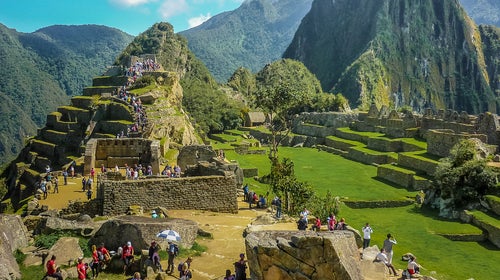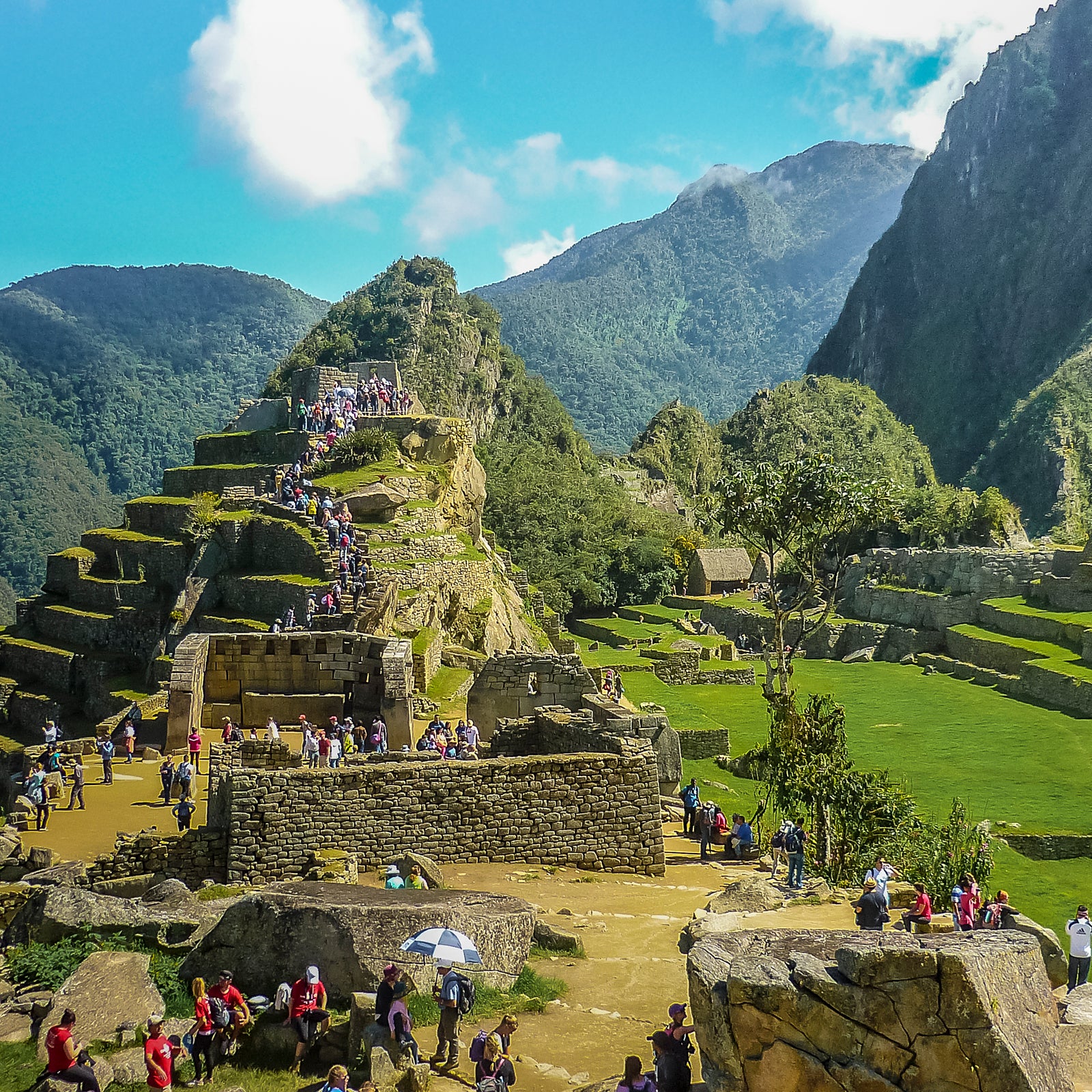On the morning of October 26, workers removed a long chain drilled into the side of Uluru, a block of sandstone larger than downtown London in the middle of the Australian outback. Since the 1950s, the chain has led millions of tourists up the rock’s sheer face to its summit, 2,800 feet above the desert floor. In stark contrast, at the base of the trail, a simple white sign read, “We, the Anangu traditional owners, have this to say: Uluru is sacred in our culture. It is a place of great knowledge. Under our traditional law climbing is not permitted. This is our home, please don’t climb.”
In spite of this plea, a hundred or so tourists climbed the rock every day. Some fell to their deaths, some relieved themselves on the rock, and all walked over a sacred site on their way to the top. Which is why, in 2017, Uluru-Kata Tjuta National Park announced that it would officially ban climbing by the end of this year. That spurred a headline-grabbing wave of last-ditch visitors and to the summit.
Ironically, the last surge of climbers is an extension of what’s plagued the site for so long and only gives credence to the argument for its closure. But it also signals progress in how indigenous sites are viewed at a federal level and marks a long-awaited victory for the Anangu.
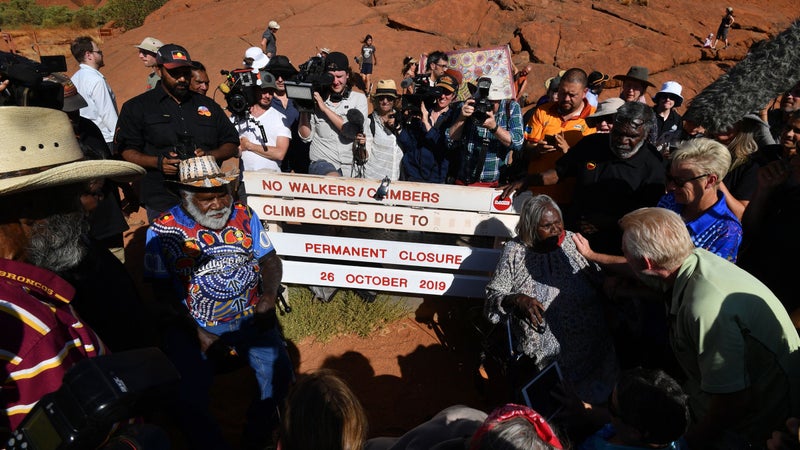
The park, which has been jointly managed by the Anangu government and the Australian National Park Service , has been preparing to close climbing for nearly a decade. A 2010 management plan outlined alternatives to the climb, including a more extensive trail system at the base and better interpretation of the rock’s spiritual significance. “We welcome tourists here,” said Sammy Wilson, an Anangu member who formerly sat on the park’s board. “Closing the climb is not something to feel upset about but is a cause for celebration. We are not stopping tourism, just this activity.”
That attitude, says Uluru operations manager Steve Baldwin, has garnered support from both tour operators and the visitors themselves. The percentage of climbers has declined by about half over the past eight years, while total visits have increased, indicating that more people are abstaining from summiting the rock. Indigenous park managers have also developed a curriculum for guides to focus more on the religious aspects of the location. “Almost every single tour, someone will say to my guides, ‘I wanted to climb, but after hearing that, I’ve changed my mind,’” Baldwin says.
Uluru, with its joint management strategy and investment in ethical alternatives, could become a successful example for other culturally sensitive tourist destinations. But such intervention from federal government is rare and sluggish—Anangu leaders have been pushing for the rock’s closure for more than 30 years. In many parts of the world, the travel industry is still entwined with a colonial history that continues to exploit local culture and sacred places, profiting off stolen land or degrading sites in exchange for entrance fees. But the answer isn’t to stay home and watch Netflix. While it might not be possible to practice perfect tourism, there are ways to do better: engage with the culture and history of sacred places, visit sites interpreted by their traditional owners, and avoid overcrowded destinations. Here, we’ve outlined how you can do your bucket list better.
Riviera Maya, Mexico
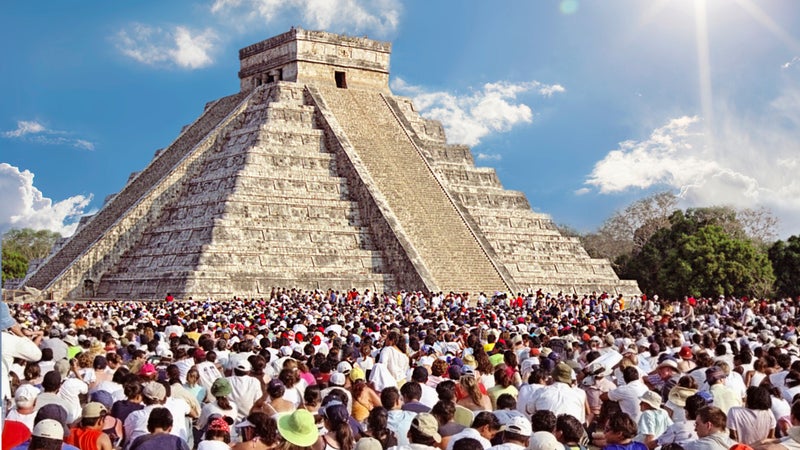
In the Yucatán’s Mayan Riviera, home to boozy Cancun to the north and the ancient temple sites of Chichén Itzá to the west, the issue is as much about degradation as equity. Many of the most famous pyramids, including the Temple of Kukulcan, have been closed to climbing in recent years for the sake of preservation, but the larger issue is that Maya people are largely left out of the interpretation of the sites. “Maya people are an active part of Mexico today, but that’s not a story that’s told to tourists,” says Richard Leventhal, an anthropologist at the University of Pennsylvania who works closely with communities in the region. Instead, he says, “there’s a sense that the great Maya culture has disappeared,” and the Maya are excluded from the interpretation of classical historical sites. The country’s federal system also funnels revenue from popular sites like Chichén Itzá and Tulum National Park into the national museum system instead of local cultural preservation efforts, and artifacts found in the region are often sent to Mexico City for storage.
Go Here Instead: Traci Ardren, an archaeologist at the University of Miami, recommends taking a trip to Yaxuná, a small farming town 100 miles inland from the coast, which once sat at the crossroads between several Mexican empires. Unlike the resort towns of Playa del Carmen and Tulum, many of which are owned and operated by expats, there are no formal hotels or restaurants in the area. As an alternative, Ardren recommends that visitors arrange homestays and food with the help of a local guide. The town features the remains of a , thousand-year-old temples, and an 80-foot vine-covered pyramid rising out of the jungle, as well as a museum and cultural center that’s run by the local Maya community.
For an understanding of how contemporary Maya people view their archaeological heritage, visit the in Tihosuco, a two-hour drive south from Yaxuná. The museum is just one piece of a larger Tihosuco Caste War Project, a collaboration between Leventhal, other American researchers, and the community to explore a little-known 19th-century war of independence fought by the Maya against the Mexican government. Designed for an international audience, the museum houses spectacular artifacts from the war, and it’s possible to visit old churches and haciendas in the surrounding jungles. “It’s a very different view of tourism to understand the people behind those great things,” Leventhal says.
Machu Picchu, Peru
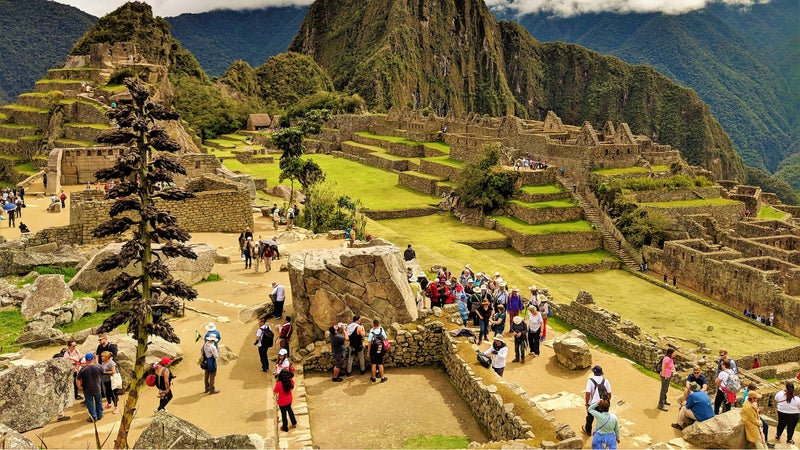
More than a million people visit Machu Picchu each year, which forced the Peruvian government to in 2017, though it was double the number recommended by Unesco. And even with the trains-planes-and-automobiles itinerary required to reach the Citadel from beyond Cusco, that visitor count still averages 6,000 per day. Easier access would not only exacerbate that problem but also threaten another culturally significant site. In the Incan town of Chinchero, at the mouth of the valley leading to Machu Picchu, an international airport is under development. Despite outcry from archaeologists and locals alike, the government has broken ground. Monica Ricketts, a Peruvian-born historian who helped to stop the airport earlier this year, describes the project as an ecological and cultural disaster: the bulldozing will threaten a pristine archaeological site that’s known as the gateway to the Sacred Valley, while the resource requirements could drain lakes that provide water to Cusco and surrounding towns. “There’s ancient farming going on, growing some of the best potatoes in the world,” Ricketts says. “People literally live on this water.”
Go Here Instead: Peru is full of underappreciated destinations, from the in the north to the Atacama Desert’s . If you do want to see the center of the Incan empire, however, spend time in the Sacred Valley, which the majority of tourists pass straight through on their way to Machu Picchu. Besides the dozens of temples, farms, and ancient salt flats, Ricketts suggests visiting and supporting the town at the center of the fight against the airport. Chinchero is home to the remnants of an unaltered 500-year-old royal estate, working aqueducts, and terraced farmland dating back to the height of the Incan Empire. It’s also the home of a thriving weaving community. Women in still use traditional dyes and techniques and offer tours and demonstrations. Some of them are organizing against the airport, which they say could destroy both the tourism they rely on and the ecosystems that fuel their livelihood.
Mount Fuji, Japan
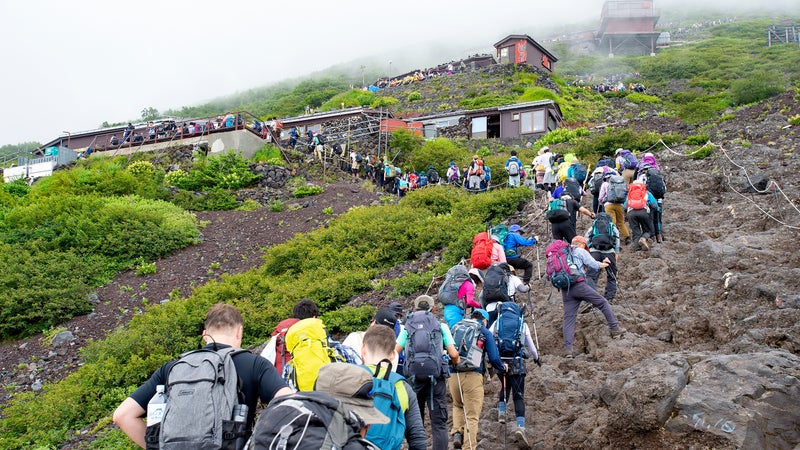
Two years ago, declared that Mount Fuji was “at the breaking point.” Since 2013, climbing has been limited to a brief window in late summer to protect tourists unprepared for fickle weather. This means that hundreds of thousands of people pack onto the mountain over a handful of weekends. As seen with Uluru, that’s led to some predictable problems: thrown just off the trail and traffic jams to the summit.
Do It Right: Mount Fuji, unlike many of the other locations on this list, is sacred in large part because it is a climbing destination. Since the 1600s, religious pilgrims have hiked from temples at the base to watch the sunrise from the 12,388-foot summit. The key is to climb respectfully. To start, visit on a weekday, when the crowds die down. Climbs to the top, the , “should be accompanied by an overnight stay or a short stay at a mountain hut on the way,” as opposed to so-called bullet climbing, or racing straight to the top and down again in a single day. The goal, the council says, is to preserve those ancient pilgrimage practices. So climb it—but also visit a shrine at the base, stop in at the huts on the route, and treat the mountain not just as a peak to be bagged but a tradition to take part in.
Angkor Wat, Cambodia
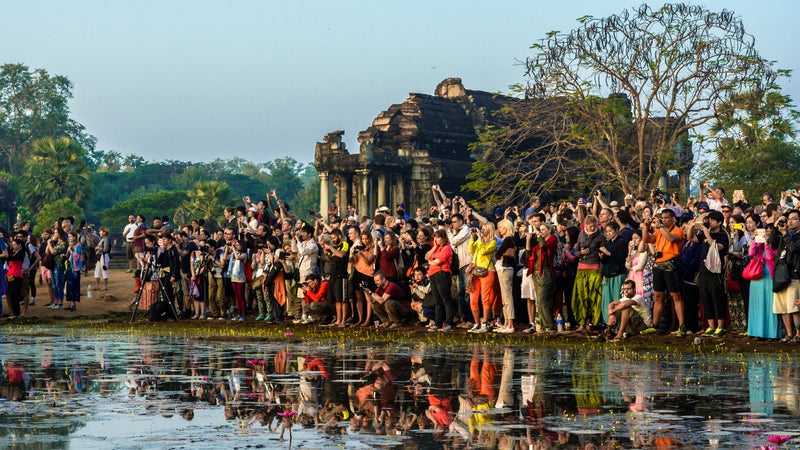
The sprawling temple complex faces many of the same threats as other hyperpopular religious sites in the region. Since the ruins were named a Unesco World Heritage Site in the early 1990s, the gateway city of Siem Reap has exploded in popularity. Nearly 3 million tourists flocked to the area in 2018—about a third of all visitors to Cambodia. While the temple site itself is protected by strict rules on where to walk and what to touch, the traffic has taken a toll on the literal foundations of the region. According to a , hotels and other tourism businesses have tapped the underlying aquifer with thousands of illegal wells, sucking out tens of thousands of gallons per day. That causes the sandy soil to collapse, threatening both the city and Angkor Wat itself. In other words, pretty soon the site could begin to sink.
Go Here Instead: Unfortunately, in Southeast Asia face similar threats from overtourism and mismanagement. Sri Lanka’s Cultural Triangle, in contrast, is less visited and built to accommodate domestic pilgrims and monks. Both Anuradhapura and Polonnaruwa, which were once capitals of classical Sri Lankan kingdoms, are home to intricately carved temples, historic stupas, and complex systems of aqueducts and reservoirs dating back thousands of years. Between the two cities is Sigiriye, a 600-foot piece of bare rock with an ancient palace carved into its top. Some places, like the temple at Anuradhapura—home to a from the sacred Bodhi Tree—are active worship sites, and you’ll need to respectfully observe local practices, including covering your shoulders and knees and wearing white.
Mount Rushmore National Memorial, United States
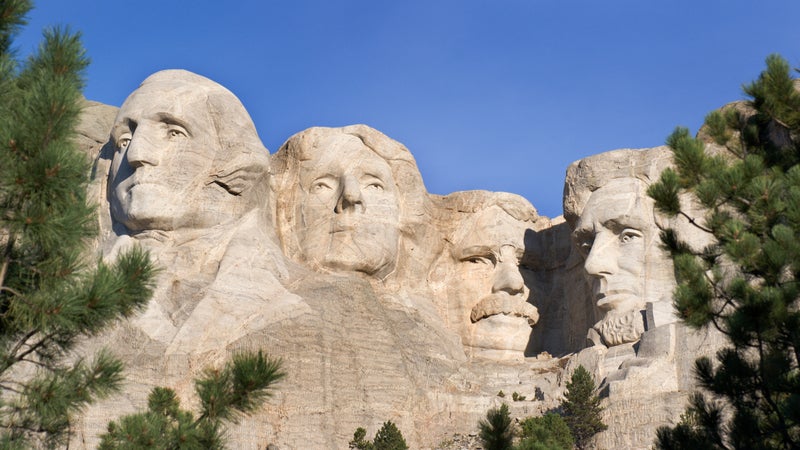
There are a couple of strikes against this national memorial. First, it was carved by an alledged white supremacist as a monument to a colonial, expansionist, Anglo-Saxon America. That history is especially disturbing when you consider its location: the Black Hills of South Dakota. Sacred to more than 20 Native nations for thousands of years, the originally placed the entire region under indigenous control. But six years later, a few prospectors discovered gold in a Black Hills creekbed. In the subsequent rush, the United States launched a against the Lakota and other nations to control the area’s mineral wealth. That history still informs the present: until the 1970s, Native communities were prohibited from holding religious ceremonies in their sacred sites, and resource extraction and tourism development continue to disrupt those practices. To many nearby indigenous communities, Mount Rushmore is a damning reminder of that broken treaty and the ensuing massacres, literally carved on a sacred mountain range.
Go Here Instead: There’s not really a comparable replacement for Mount Rushmore, and it’s hard to find places that tell the Native story of the area. But Teanna Limpy, a tribal historic preservation officer with the Northern Cheyenne Nation, says that’s slowly shifting. “ is redoing its whole interpretive center with Native input. Now they don’t finalize anything until they talk to us,” she says of the complex cave system and surrounding park, an hour south from Mount Rushmore. Limpy also points to , in the northeastern corner of the Black Hills, as a success story. The mountain is an important pilgrimage and prayer site for a number of cultures, including the Lakota, Northern Cheyenne, and Arapaho. Jim Jandreau, the park’s manager and a registered member of the Lower Brule Lakota, says he actively seeks input from surrounding Native communities in managing the area. That’s meant giving religious visitors more access and being upfront with tourists about the complicated history of the mountain. “We try to enlighten people to why the tribes feel the way they feel, why the dignity of this place was stripped away and is finally coming back,” he says. If you do visit, treat Bear Butte as you would a church—it’s possible that people will be praying nearby or have left offerings off-trail—and make time to ask park staff about what it means to manage a religious site on public land.
